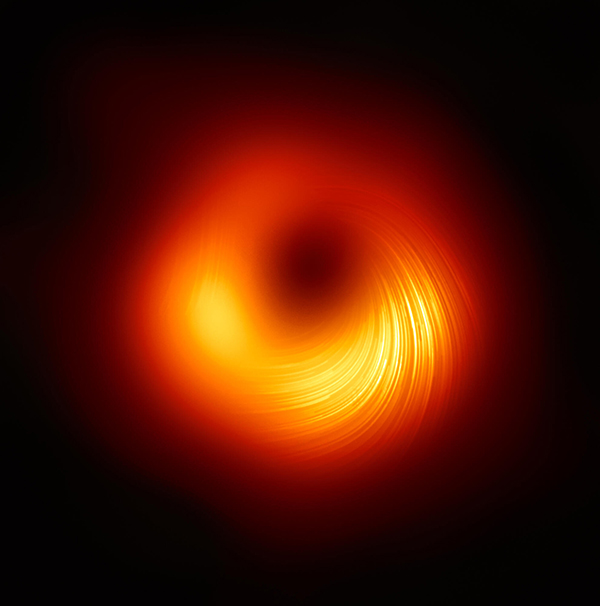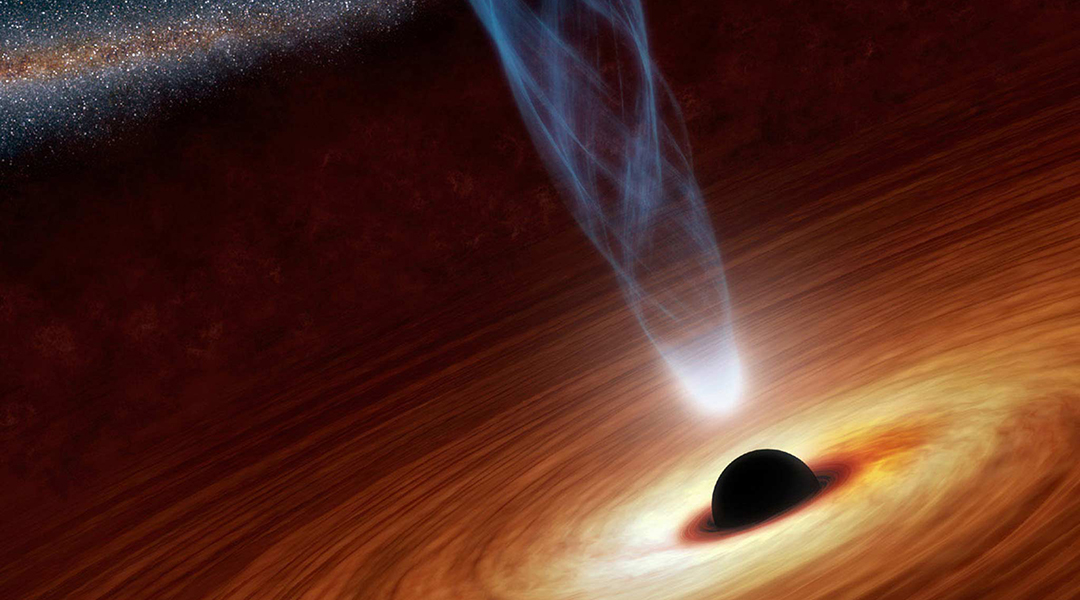New observations of the supermassive black hole at the heart of the galaxy, Messier 87 (M87), which, thanks to the Event Horizon Telescope, was the first black hole ever imaged by humanity, suggest there is a way that energy from within a black hole could leak into its surroundings.
Astrophysicists from Princeton University and Vanderbilt University have determined that the event horizon of this supermassive black hole — named M87* — with a mass equivalent to around 6.5 billion suns, seems to be pushing outward. The team thinks this is causing outflows or jets to be launched, stripping energy from the black hole.
One team member, Vanderbilt University assistant professor of physics Math Alexandru Lupsasca, colorfully described these outflows as “like million-light-year-long Jedi lightsabers”. That means a galactic lightsaber that is around ten times as long as our home galaxy, the Milky Way.
“Even though black holes are defined as objects from which nothing can escape, one of the astonishing predictions of Einstein’s theory of relativity is that black holes can actually lose energy,” Princeton astrophysicist Eliot Quataert said in a statement. “They can rotate, and just like a spinning top slows down over time and loses that energy in its rotation, a rotating black hole can also lose energy to its surroundings.”
Quataert is one of the authors of a paper published in the Astrophysical Journal detailing these findings, which could revolutionize what we know about black holes.
Black holes are such a drag
The new observations revealed by the team concern some of the most fundamental ideas about black holes, their boundaries, rotational spin, and magnetic fields.
One of the earliest ideas about black holes, predating even Einstein’s 1915 theory of gravity, general relativity, was that some stars could have gravitational pulls so great that even light would not be fast enough to meet and exceed their escape velocity.
While working with the equations of general relativity, German physicist and astronomer Karl Schwarzchild discovered that bodies with mass would have a radius at which their escape velocity exceeded the speed of light in a vacuum. Past this point, nothing, not even light, could escape.

This is now known as the Schwarzchild radius, and for bodies like the Earth and the Sun, it is deep with their bodies, but if a large enough mass could be compressed enough, the Schwarzchild radius would be far from its heart.
Schwarzchild also discovered that a singularity arises in general relativity where all the laws of physics essentially fail, and infinite mass is compressed to an infinitesimally small point. This would become the heart of the black hole and the Schwarzchild radius serves as its outer boundary or the black hole’s event horizon.
Following this, researchers determined that if black holes have angular momentum — and the fact that they are born from the collapse of massive spinning stars means they should — then they would be rotating. Because of the immense mass of black holes, this rotation drags the very fabric of space and time around with them — a phenomenon called “frame dragging” or the “Lense-Thirring effect” after the scientists that discovered it.
This frame dragging creates a region around a black hole where nothing can sit still, called the ergosphere. Frame dragging should also mean that as black holes rotate, the magnetic fields threaded through the ergosphere “twist up”, and since the 1970s, this has been suggested as an avenue by which black holes could lose energy.
A twisted new theory of black hole energy flow
In a separate paper, also recently published in the Astrophysical Journal, a team of scientists led by Andrew Chael, a physicist at Princeton University, observed the direction in which M87* is causing its magnetic field lines to spiral and thus the direction in which energy from the black hole should be flowing. Armed with this information, Quataert said that the rest sort of fell into place.
“Our new, sharp prediction is that whenever you look at an astrophysical black hole if it has magnetic field lines attached to it, there will be energy transfer — truly insane amounts of energy transfer,” Lupsasca added.
Just how insane? The team estimated that if the entire mass of Earth, 5.97 billion trillion metric tons, were turned into TNT and then exploded this 1,000 times a second for millions and millions of years, that would be equivalent to the amount of energy coming from the supermassive black hole M87*.
The team added that not all black holes rotating and undergoing this process would be pushing energy outward. Some could be spinning in the same way that the rotational energy being leached by twisting magnetic fields is instead channeled back into the black hole toward its central singularity.
To fully confirm this black hole energy flow theory, the team will turn to the next generation of telescopes after the Event Horizon Telescope.
“It is incredibly exciting! Linking energy outflow to such a simple observable like this is a critical step on the path to obtaining direct observational evidence of black hole energy extraction,” team member and Princeton University astrophysicist George Wong said. “I look forward to seeing what kind of robust statements we’ll be able to make with the next generation of black hole images — and movies!”
Reference: A. Chael., A. Lupsasca., G. N. Wong., E. Quataert., Black Hole Polarimetry I. A Signature of Electromagnetic Energy Extraction, the Astrophysical Journal, DOI: 10.3847/1538–4357/acf92d
Feature image: An illustration of a jet of energy erupting from a supermassive black hole. Credit: NASA/JPL-CALTECH

















